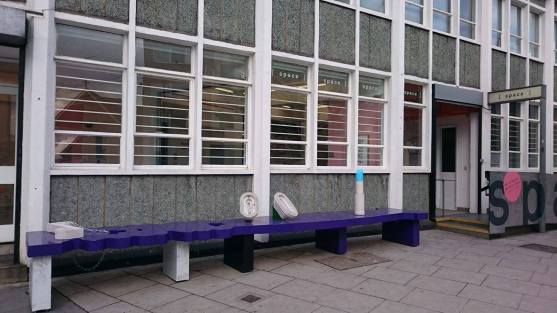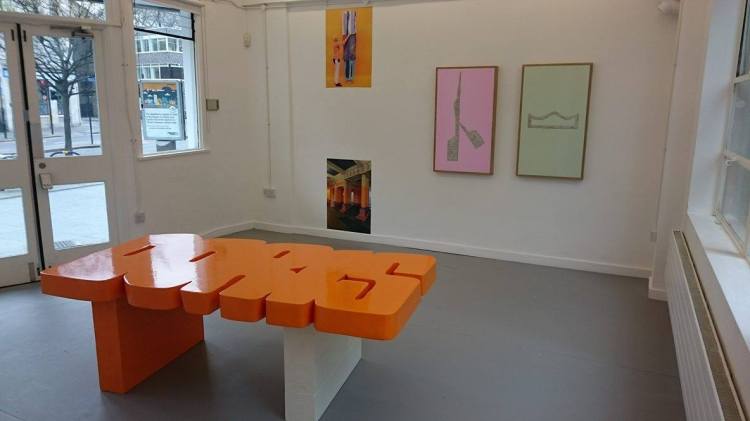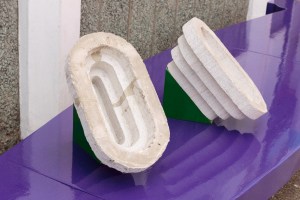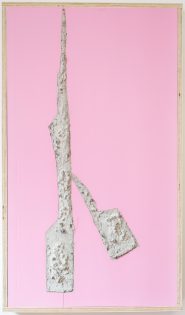In 1962, the Minimalist Robert Morris staged a seven-minute performance titled Column at the Living Theatre in New York which involved toppling down an erect plywood box half way through. Nowadays, the art audience is more familiar with his enormous Untitled (L-Beams) and sagging felt sculptures than his affair with experimental theatre but a similar gesture to Morris’ fallen pillar has, by great chance, found its way into the streets of contemporary Hackney in London.

‘Iconic’ by Marusa Sagadin, concrete and wood sculpture, Space Gallery
Outside the Space Gallery, which hosts “Doris Ionic Iconic” her first UK exhibition, the Vienna-based artist Maruša Sagadin, has installed a large purple bench, fine and shiny as any other Minimalist object. A selection of accessories, among them a large concrete lipstick and a lavender-coloured necklace, sit on top while walking around the sculpture reveals the word ‘ICONIC’ carved into its surface. Meanwhile, another bench, or table, thrones inside the gallery and reads ‘DORIS’ in graffiti-like orange font.
Tina Di Carlo, in the conversation she had with Marusa at the Space, explains in her essay that the inscribed terms deliver the artist’s playful verbal puns on ‘ionic’ and ‘doric’, respectively, two of three classical column designs prevalent in antiquity. Both of the column types of are virtually knocked down by Sagadin’s simple, yet ingenious act of turning them into benches and tables (thus surpassing Morris’ deed) – verticality collapses into horizontality, spot into site, privileging height into democratising plane. What once used to be a supportive but passive building unit carrying the weight of gods-dedicated temples assumes a new role as an active platform around which all people can gather, sit and talk.

‘Doris’ by Marusa Sagadin, concrete and wood sculpture, Space Gallery
“What once used to be a supportive but passive building unit carrying the weight of gods-dedicated temples assumes a new role as an active platform around which all people can gather, sit and talk.”
The irreverent, almost anti-establishment attitude to columns runs parallel to other areas of exploration in Sagadin’s oeuvre. Having studied architecture and sculpture, the artist delves into the processes of the production, representation and public use and how these columns further impact ‘who has access to which infrastructure- the infrastructure that is today strongly connected to consumerism and economical availability.’ It is to contradict the capitalist grip on our streets, parks and terraces in the form of signage and branding that Sagadin places her sculpture directly into the street, its mirror surface reflecting the transient urban life rather than a corporate logo: ‘I want to stress the urge for such spots that don’t have a certain function and that are not connected to consumerism or action.’
Tellingly, however, her pieces utilize the same strategy as advertising campaigns by the means of saturated colours and glossy finish. They tread a fine line between appropriation and subversion of capitalist mechanisms, recognizing that in order to compete against them, one has to, ironically, play according to their rules.

O – Two – Maruša Sagadin
With only eight works on display, Sagadin demonstrates interest into a wide range of issues, alluding to famous architects (Zaha Hadid, Lina Bo Bardi), urban culture (graffiti, hip-hop, street spectacle), the already discussed commercialisation of public spaces and, in works like O-Two, even asymmetrical occupation of the city by genders.
Here, a lean anthropomorphic figure wobbles on high platform shoes against an electrifying pink background (after all, the word ‘ionic’ denotes not only a kind of column but also a charged atom).
I believe that this wall object (Sagadin’s own terminology) unleashes so far the greatest matrix of associations, creating an object out of architectural materials- concrete and polystyrene- in a painting frame with sculptural tactility. Again, colour becomes one of the entry points for understanding the work: ‘The presence of pink is indicative, I have used it in my past works, too. It could be read as a feminine but also as a feminist colour. Or, as one of my older show posters said: Pink is Punk and Silver is Space.‘
The intended female empowerment is however, immediately eroded by the size and weight of the footwear which, as the artist admits, represents something ‘unbearable and unwearable.’
Ultimately, Maruša’s staggering figure could be a visualisation of the existing remnants of the past or, if her emancipating message is to be applied, it could represent a teetering female body that is, however, still upright and not tumbling down.
“That adds up- cities have traditionally been designed with male residents in mind, women’s spaces were, of course, the domestic interiors and even today, we still do not stand on an equal footing.“

‘Platforms’ by Marusa Sagadin, concrete and polystyrene sculpture, Space Gallery
The Austrian artist’s debut on the UK art scene surprised me. Despite the exhibition’s unassuming and modest scope, the art works not having their titling labels, the accompanying video not working when I visited and nobody actually making use of the sculpture outside, I spent a considerable time there and learnt a great deal of things. Her timely enquiries in urban design, architectural structures and the systems they impose on city inhabitants are wise and engaging, commenting on historical precedents while articulating new ways of living in space. Maruša Sagadin accomplishes what Donald Barthelme worded as ‘our good fortune [enabling us] to imagine alternative realities, other possibilities. We can quarrel with the world, constructively.’
Maruša Sagadin Official Website
Maruša Sagadin on The Space Studio Official Website
Maruša Sagadin on the Austrian cultural forum london
Maruša Sagadin on YouTube

Discussion
No comments yet.